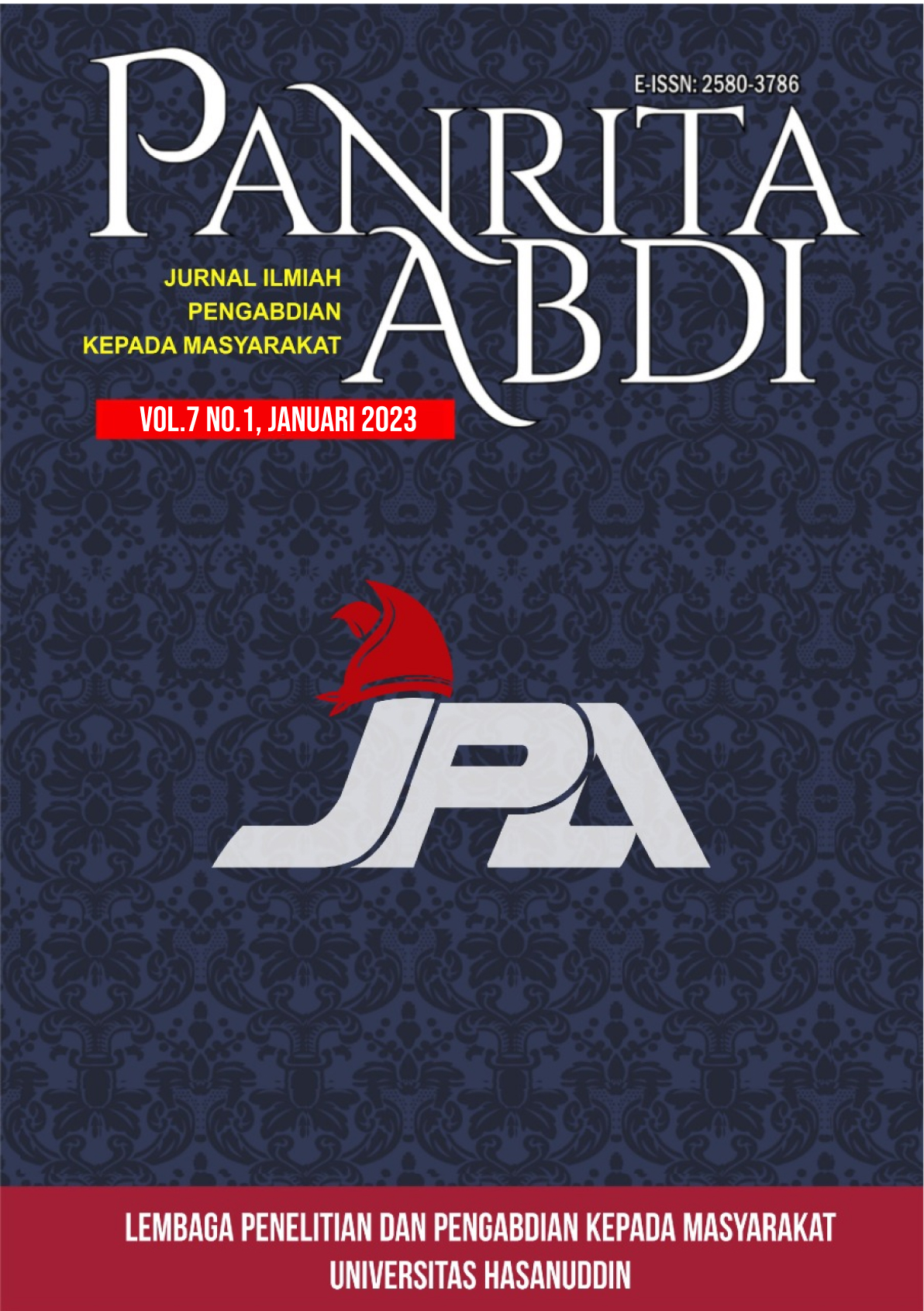PELATIHAN PENGOLAHAN FORMULA TEMPE GENERASI DUA BAGI IBU BALITA GIZI KURANG
DOI:
https://doi.org/10.20956/pa.v7i1.20480Keywords:
Training, second generation tempe, under-five children, undernourishedAbstract
Until now, the prevalence of malnutrition in children under five is still high. Tempe is an affordable local food, contains high protein, and is easy to digest by the human body. A collection of tempeh recipes for undernourished children, designed based on recipes from local communities, has been successfully developed through previous research. These recipes are assigned as the second generation of tempeh to distinguish them from conventional tempe products. This current community service aimed to provide training on how to cook tempe formulas using standard recipes from the preceding research. The participants of the community service activities were mothers who have under-five malnourished children and Posyandu cadres of Arjowinangun Health Center, Malang City, with a total of 15 mothers. The program was carried out for three non-consecutive days. The methods used during activities included lectures, discussions, cooking demonstrations, and cooking independently at the participants' own homes. The home activities were done twice, with two recipes for each practice. The results of the community activity showed that the participant's pretest and post-test scores were 68.70 and 84.00, respectively. The distribution of post-test scores was more homogeneous than the pretest scores. These indicate that at the end of the activity, the comprehensive understanding of the participants on the material that has been presented is not only better but also relatively uniform. The post-test score is higher than the passing grade level set for the program, which is 75%. The qualities of the tempe formula prepared by the participants, based on taste, appearance, texture, and aroma sensory attributes, have been notably increased from home activities one and two. Again, this indicates that the participant's skills at preparing second-generation tempe products have increased. --- Sampai saat ini prevalensi gizi kurang pada anak balita tinggi. Tempe merupakan makanan lokal yang mudah didapatkan, mengandung protein tinggi, dan mudah dicerna oleh tubuh. Kumpulan resep olahan tempe untuk balita gizi kurang, yang dirancang berdasarkan resep dari masyarakat setempat, telah berhasil dibuat oleh penelitian terdahulu. Resep-resep tersebut diberi nama olahan tempe generasi dua untuk membedakan dengan resep olahan tempe konvensional. Kegiatan pengabdian masyarakat ini bertujuan untuk memberikan pelatihan cara memasak olahan tempe dengan menggunakan resep standar yang dihasilkan dari penelitian tersebut. Sasaran kegiatan pengabdian adalah ibu-ibu yang memiliki balita gizi kurang dan kader Posyandu di wilayah kerja Puskesmas Arjowinangun, Kota Malang dengan jumlah total 15 orang. Kegiatan dilakukan dalam waktu 3 hari secara berselang. Pelaksanaan kegiatan dilakukan dengan metode ceramah, diskusi, demo memasak dan praktik masak olahan tempe secara mandiri di rumah peserta masing-masing. Kegiatan praktik mandiri dilaksanakan sebanyak dua kali dengan jumlah dua resep untuk setiap kali praktik. Hasil kegiatan menunjukkan bahwa nilai tes awal dan tes akhir peserta berturut-turut adalah 68,70 dan 84,00. Sebaran nilai tes akhir lebih homogen dibandingkan dengan nilai tes awal. Hal-hal tersebut mengindikasikan bahwa di akhir kegiatan, tingkat pemahaman peserta terhadap materi yang disampaikan selain lebih baik juga relatif lebih seragam. Dibandingkan dengan indikator keberhasilan kegiatan, yaitu 75%, maka nilai tes akhir lebih tinggi. Mutu makanan olahan tempe yang dihasilkan peserta, ditinjau dari parameter rasa, penampilan, tekstur, dan aroma pada praktik kedua lebih baik dibanding pada praktik yang pertama. Hal ini juga menunjukkan bahwa keterampilan menyiapkan olahan produk tempe peserta mengalami peningkatan.
References
Dinkominfo. (2018). Balita kurang gizi dan gizi buruk 2014—2016. https://opendata.malangkota.go.id/data/kesehatan_gizi_balita/2016
Fellows, P. (2017). Food processing technology: Principles and practice (4th ed). Woodhead Publishing.
Frestian, S. (2014). Analisis Karakteristik dan Identifikasi Kendala yang Dihadapi UMKM Di Kota Malang (Studi Kasus Pada Sentra Industri Tempe Sanan). Universitas Brawijaya.
Kudsiah, H., Rahim, S.W., Rifa’i, M.A., & Arwan. (2018). Demplot Pengembangan Budidaya Kepiting Cangkang Lunak di Desa Salemba, Kecamatan Ujung Loi, Kabupaten Bulukumba Sulawesi Selatan. Jurnal Panrita Abdi, 2(2), 151-164.
Kristianto, Y., Fitriah, A. H., & Astuti, W. D. (2015). Processing practice of second generation tempeh recipein centre of tempeh home industry in Malang. Buletin Penelitian Sistem Kesehatan (Bulletin of Health System Research), 18(2), 197–202.
Nakazawa, M (2022). Functions for Medical Statistics Book with some Demographic Data. R package version 0.7.3. https://CRAN.R-project.org/package=fmsb
Parks, E. P., Mascarenhas, M. R., & Goh, V. (2020). Nutrient needs and requirements during growth. In Present Knowledge in Nutrition (hal. 23–44). Elsevier.
R Core Team. (2018). R: A Language and Environment for Statistical Computing. R Foundation for Statistical Computing. https://www.R-project.org/
Rifa'i, M.A., Muzdalifah, & Kudsiah, H. (2018). Pengembangan Usaha Produk Intelektual Kampus: Anemon Laut Ornamen. Panrita Abdi Jurnal, 2(1), 40-47.
Rifa’i, M.A., Candra, Muzdalifah, & Kudsiah, H. (2020). Pemberdayaan Istri Kelompok Pembudidaya Ikan Patin dengan Pengembangan Produk Fillet. Jurnal Panrita Abdi, 4(3), 369-379.
Rifa’i, M.A., Candra, Muzdalifah, Agustina, & Kudsiah, H., Mubarak, M.S., & Norliana. (2021). Transfer Teknologi Pembuatan Sosis Berbahan Baku Ikan Patin (Pangasius sp) bagi Kelompok Pembudidaya Ikan dan Keluarganya. Jurnal Panrita Abdi, 5(4), 589-599.
Rochimiwati, S.T., Mas’ud, H., & Adam, A. (2022). Pemanfaatan pangan lokal menjadi snack sebagai makanan tambahan bagi ibu hamil. Jurnal Panrita Abdi, 6(1), 169-175.
Sutiari, N. K., Widarsa, K. T., Swandewi, A., & Widarini, P. (2011). Profil asam amino ekstrak seredele dan tempe kedelai, makanan tradisional hasil fermentasi. Prosiding Seminar Nasional MIPA.
UNICEF, WHO, & World Bank. (2020). Levels and trends in child malnutrition:Key Findings of the 2020 Edition of the Joint Child Malnutrition Estimates. Geneva: World Health Organization; 2020.
Wulandari, A. (2018). Analisis upaya industri keripik tempe dalam mempertahankan keberlangsungan usaha di Kampung Sanan Kota Malang. Universitas Negeri Malang.
Yusriansyah, M. (2012). Karakteristik pengusaha industri keripik tempe berbasis produk unggulan di Kota Malang. Jurusan Geografi-Fakultas Ilmu Sosial Universitas Negeri Malang.
Downloads
Published
How to Cite
Issue
Section
License
Copyright (c) 2022 Yohanes Kristianto, Annasari Mustafa, Maryam Razak, Sri Endang Surowati

This work is licensed under a Creative Commons Attribution-NonCommercial-NoDerivatives 4.0 International License.











